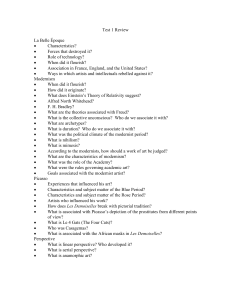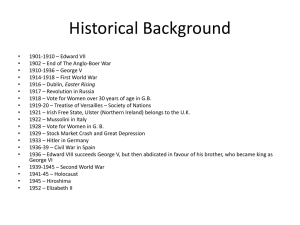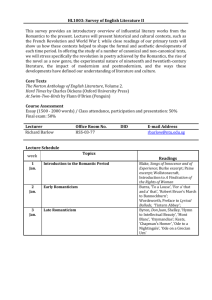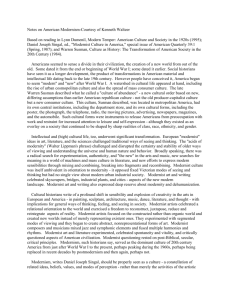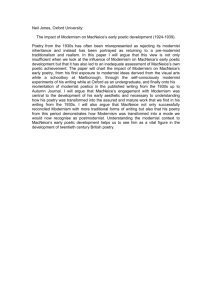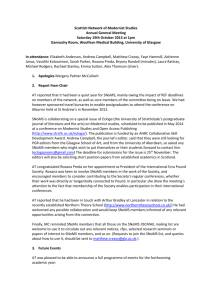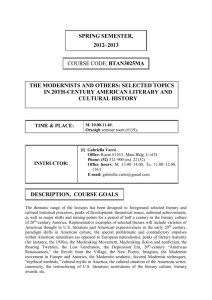“… bright young modernists” in Canada
advertisement
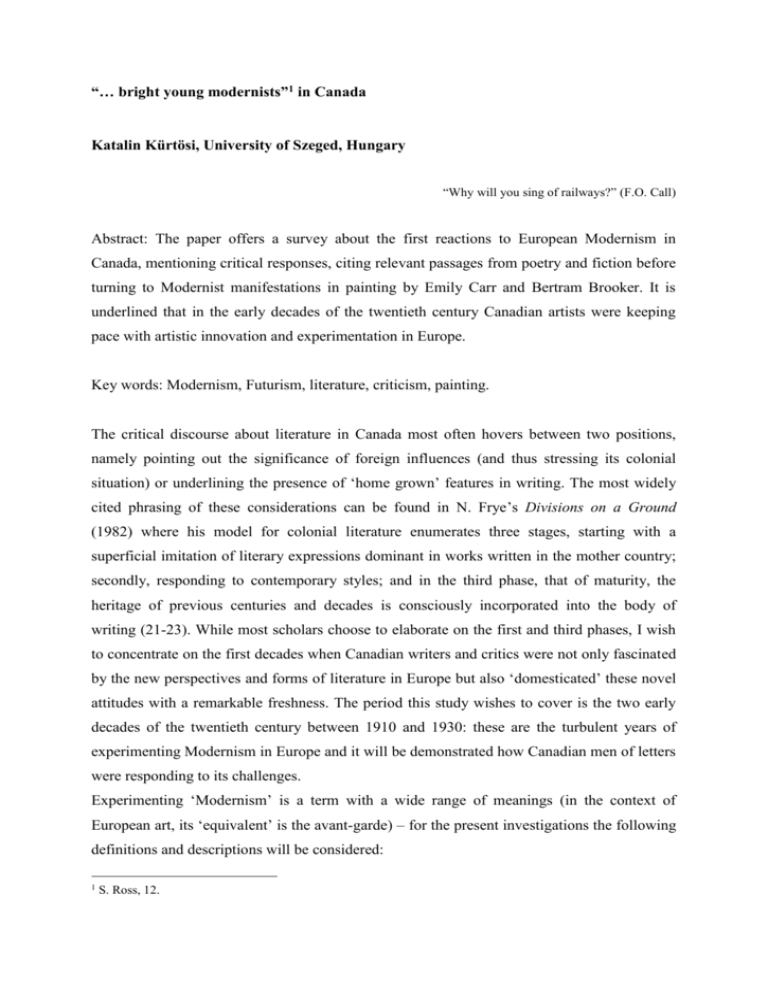
“… bright young modernists”1 in Canada Katalin Kürtösi, University of Szeged, Hungary “Why will you sing of railways?” (F.O. Call) Abstract: The paper offers a survey about the first reactions to European Modernism in Canada, mentioning critical responses, citing relevant passages from poetry and fiction before turning to Modernist manifestations in painting by Emily Carr and Bertram Brooker. It is underlined that in the early decades of the twentieth century Canadian artists were keeping pace with artistic innovation and experimentation in Europe. Key words: Modernism, Futurism, literature, criticism, painting. The critical discourse about literature in Canada most often hovers between two positions, namely pointing out the significance of foreign influences (and thus stressing its colonial situation) or underlining the presence of ‘home grown’ features in writing. The most widely cited phrasing of these considerations can be found in N. Frye’s Divisions on a Ground (1982) where his model for colonial literature enumerates three stages, starting with a superficial imitation of literary expressions dominant in works written in the mother country; secondly, responding to contemporary styles; and in the third phase, that of maturity, the heritage of previous centuries and decades is consciously incorporated into the body of writing (21-23). While most scholars choose to elaborate on the first and third phases, I wish to concentrate on the first decades when Canadian writers and critics were not only fascinated by the new perspectives and forms of literature in Europe but also ‘domesticated’ these novel attitudes with a remarkable freshness. The period this study wishes to cover is the two early decades of the twentieth century between 1910 and 1930: these are the turbulent years of experimenting Modernism in Europe and it will be demonstrated how Canadian men of letters were responding to its challenges. Experimenting ‘Modernism’ is a term with a wide range of meanings (in the context of European art, its ‘equivalent’ is the avant-garde) – for the present investigations the following definitions and descriptions will be considered: 1 S. Ross, 12. 2 modernism is a “self-reflexively experimental aesthetic practice that produces its meaning in dialogue with a social field characterized by historical modernization” (Willmott, 2005, 101). “As the author appears in the text, so does the painter in the painting. The reflexive text assumes the centre of the public and aesthetic stage, and in doing so declaratively repudiates the fixed forms, the settled cultural authority of the academies and their bourgeois taste” (Williams, 33). The high point of the avant-garde has usually been considered […] the 1910-30 period when expressionism, futurism, dadaism, surrealism, and constructivism were to generate antagonistic and visionary impulses which signalled a vital tradition of social radicalism and social innovation (Bayard, 3-4). M. A. Gillies enumerates some widely accepted features of modernism – for our purposes, the stress on abstract art forms, aesthetic self-consciousness, radical innovation, fragmentation and shock, the breaking of formal and linguistic conventions and the use of paradox, the wish to create new art that would reflect the new social realities are of most importance (2). The main targets of attack in this new art were the dominating styles of the nineteenth century, i.e. Romanticism and Realism. Canadian writers and painters also fired at their predecessors’ featuring of the typical elements of Romanticism, which in many cases went hand in hand with expressions of national sentiments. Modernists favoured the genre of the manifesto to announce their (very often contradictory) views about the relationship of social reality and artistic expression – Marinetti’s futurist manifesto of 1909 can serve as a typical example of this form of communicating new convictions about art and life, and at the same time, it can be regarded as the initial step toward unrestricted artistic experimentation in the early twentieth century. In Québec, the first references to the Futurists appeared on August 17th, 1912 when le Devoir published an article by Georges Malet on “The Futurist School – New Literary Rules” which had appeared in la Gazette de France, Paris a few days earlier. Three weeks later the same daily had another article about Marinetti and his movement, starting a debate about his views – and concluded with refusing them (Bourassa, 48). Poets of the time, however, were more welcoming towards innovations: Guillome Lahaise (1888-1969) published, under the pen name of Guy Delahaye, a volume of ‘cubo-futurist’ poems in 1912 – “Mignonne, allons voir si la Rose…” – of which there were two editions in Montréal that year. In English Canada the first references to futurism are dated 1914, but in an ironic way some of its principles were present in Leacock’s Sunshine Sketches of 1912: “the ‘buses roar and hum to the station; the trains shriek; the traffic multiplies; the people move faster and faster” 3 (3). Arthur Stringer (1874-1950) published Open Water, his poetry volume in 1914: while the poems are strongly reminiscent of late-Romantic and Victorian style, his foreword contains telling references to a new way of literary representation, including principles disseminated by Futurists. Since his work and views are not widely known, it might be in place to cite his major remarks about the contemporary task of the poet: In painting and in music, as in sculpture and the drama, there has been a movement of late to achieve what may be called formal emancipation, a struggle to break away from the restraints and the technical obligations imposed upon the worker by his artistic predecessors. In one case this movement may be called Futurism, and in another it may be termed Romanticism. […] Poetry alone, during the last century, seems to have remained stable, in the matter of structure. Few new forms have been invented […] what the singer of today has felt has not been directly and openly expressed. His apparel has remained medieval. […] the iambic pentameter […] has been found by the later singer to be ill-fitted for the utterance of those more intimate moods and those subjective experiences which may be described as characteristically modern. […] poetry represents the extreme vanguard of consciousness both adventuring and pioneering along the path of future progress. […] rhythmically, the modern versifier has been a Cubist without quite comprehending it. He has been viewing the world mathematically. He has been crowding his soul into a geometrically designed mould. (5-8) Futurism was not the sole influence on Canadian poets wishing to renew their art: American imagism and free verse also played a crucial role in the efforts to break with the old forms. Although the poems in Stringer’s volume did not meet his own expectations and artistic views, his novels indirectly did have a great impact on Modernist fiction in Canada: according to the latest research, Stringer’s The Prairie Wife (published in 1915, film version in 1925) and his two consecutive novels about rural life in North America show remarkable similarities with As For Me and My House (1941) by Sinclair Ross (1908-1996), which is generally considered as the first example of truly Modernist, self-reflective fiction in Canada.2 As is well-known, As For Me and My House presents the reader with a small town preacher’s wife who is struggling to write an accurate journal about their life, relationship and frustration, while Philip, the husband takes refuge from everyday realities in his study, drawing and painting pictures about the congregation, the false facades of main street houses and also about horses – the last symbolizing freedom, artistic expression and male virility „[…] most of its formal, thematic, symbolic, and even modernist elements were borrowed from Arthur Stringer’s almost unknown prairie trilogy – The Prairie Wife (1915), The Prairie Mother (1920), and The Prairie Child (1922)”. Hill, 252. 2 4 alike, while his name in fact means ‘lover of horses’. Stringer’s novel reaches back to the epistolary tradition, giving minute details about a young lady’s experiences in a remote, rural area of the Northern Prairies. The processes of artistic creation, namely her writing and playing the piano, and his painting in As For Me and My House form thus the main thread of this novel set during the times of the Great Depression in the Canadian prairies. Both Philip Bentley and his wife used to dream about evading the prospective monotony of their lives by looking at European models or travelling to Europe: as a student he was saving his meagre income to buy “expensive volumes of French reproductions” (17), while she was “teaching and saving hard for another year’s study in the East, wondering if I might even make it Europe” (22). But having spent twelve years in various small towns on the Prairies, their dreams have evaporated, they have become estranged from one other, and Philip has become an introvert person: “Philip these last years grows more and more to himself. At times I find even myself an outsider. He retreats to his books and wants no intrusions. No little Main Street intellectuals to air their learning and discuss theology. No bright young modernists to ask him what he thinks of evolution” (12). The reference to modernism/modernists and evolution is present in the second entry of the diary – but the underlying message is that time has stopped, this childless couple is moving in a vicious circle starting it again and again in each small town: Mrs. Bentley diagnoses the situation as such when speaking about Philip hating “[the town of] Horizon, all the Horizons” and shrinking from the Church (88). “Because you’re a hypocrite you lose your self-respect, because you lose your self-respect you lose your initiative and self-belief – it’s the same vicious circle, every year closing in a little tighter” (112). Although the circle has a loop at the end of the novel with the birth of Philip’s illegitimate son3 – Philip himself was one – whose mother, Judith, dies after delivering the baby and Mrs. Bentley is ready to mother it right away, their departure from Horizon to the next small town after thirteen months suggests that only minor changes are in prospect – probably for the better, with a new life accompanying them and Philip resuming his pipe-smoking. 3 Some oher hypotheses have also been published suggesting that it is not Philip, but Paul, Mrs. Bentley’s confident, or Mr. Finley, their neighbour who fathered the baby. Hinz – Teunissen, 156-159. 5 In 1920 another poetry volume, Acanthus and Wild Grape, promoted the ideas of Futurism in its foreword: Frank Oliver Call (1878-1956) expressed that the artist had to reflect upon the new ways of perception and on the impact of speed on our life. […] verse libre, like the motor-car and aeroplane, has come to stay whether we like it or no. In France, Italy, the United States, and even in conservative England, the increase in the number of poems recently published in this form has been remarkable. The modernists hail this tendency as the dawn of a new era of freedom […] There is much beauty to be found in walking in beaten paths or rambling in fenced-in fields and woods, but perhaps one who sails the skies in an aeroplane may see visions and feel emotions that never come to those who wander on foot along the old paths of the woods and fields below. (21-22) Although in the Foreword Call seems to accept the new perspectives of Modernist writers/poets, the poems themselves contradict his openness towards them. His “To a Modern Poet” manifests self-reflection, a typical feature of Modernist art, but Call refuses topics typically Modern and opts for a return to Keatsian principles.4 Why must you sing of sorrow When the world is so full of woe? Why must you sing of the ugly? For the ugly and sad I know. Why will you sing of railways, Of iron and Steel and Coal, And the din of the smoky cities? For these will not feed my soul. But sing to me songs of beauty To gladden my tired eyes, […] For the earth has a store of beauty Deep hid from our blinded eyes, And only the true-born poet Knows just where the treasure lies. In contrast with the spirit of the Foreword, Call’s poem testifies to the poetic practice which he himself refused: the form, the rhymes alike evoke nineteenth century verse. As Trehearne observes, Call’s interest toward the Modern was more of an intellectual practice – he was so much a believer of abstract beauty that he himself seems to be doubting his dedication to Modernism. (74-75) 4 Similar preferences can be detected in Delahaye’s “AMOUR ET ART”, in a stanza called Poème synthétique: “La nature concentre en sa splendeur aimante, Les charmes de bonté, les éclats de beauté”. 6 After the less-known Modernist ideas of A. Stringer and F. O. Call, let us turn our attention to the widely recognized breakthrough of Modernism in Canada: the McGill Fortnightly Review, a short-lived student paper (November 21st, 1925 – April 27th, 1927) edited by F. R. Scott (1899-1985) and A. J. M. Smith (1902-1980) that published not only poems but also their views about what Modern literature should be like. In an essay published in December 1926, Smith elaborated on the expectations concerning modern approaches. His visions about “Contemporary Poetry” prove his remarkable sensitivity towards the innovations in the life of his days and how they should be reflected in arts. Some of his statements are worth reflection even in our days. Our age is an age of change […] that is taking place with a rapidity unknown in any other epoch. […] the whole world [is] contracted […] under the tightening bands of closer communication. Things moved faster, and we had to move with them. […] Ideas are changing, and therefore manners and morals are changing […] the arts [are] […] in a state of flux. […] Contemporary poetry reflects it as clearly as any other art. Poetry today must be the result of the impingement of modern conditions upon the personality and temperament of the poet […] We are at the beginning of an era, and who creates a new world must create a new art to express it. (27-28) Beside the typical references of Modernist artists to ‘change’, ‘rapidity’, ‘fastness’, ‘flux’, ‘the beginning of an era’, ‘new world’ and ‘new art’, mentioning “the tightening bands of closer communication” can be interpreted as forecasting Marshall McLuhan’s theorizing on the crucial role of communication in Modern world, ultimately leading to his coining the new term of the ‘global village’ some 25 years later. “Far in a corner”5, as F. R. Scott puts it, on the margin of Western culture, the impact of European experimental Modernism is not only interpreted as artistic manifestations worth following, but is also enriched by a new element, that of the crucial role of communication, as a manifestly Canadian perspective with respect to the ‘new world’ and ‘new art’. 5 “Far in a corner sits (though none would know it) The very picture of disconsolation, A rather lewd and most ungodly poet Writing these verses, for his soul’s salvation.” It is only in the April 1927 Fortnightly publication of Scott’s higly ironical “The Canadian Authors Meet” that the last stanza offers a contrast to the rejected school of Canadian poetry, while later editions of the poem omit it. Scott in these four lines draws a portrait of the Modernist poet referring to his marginal position, discontent, and the process of writing itself. 7 Poetry was not the exclusive field in Canadian art life to respond to Modernist ideas spreading in Europe and crossing the ocean: painters declared the need for change and surpassing Romanticism already in the early years of the twentieth century. A special feature of Modernism, namely ‘Primitivism’ in painting was exercised in Canada simultaneously with its breakthrough in Paris around 1906-07: Emily Carr (1871-1945) returned from her frustrating study stay in London with the firm determination that she would depict the totem poles of West-Coast native peoples before these stunning carvings decay completely. Her concept was more ‘advanced’ than that of Matisse or Picasso, since Carr observed the poles on their original location, in their natural cultural context: as she set up her mind after her visit to Sitka in 1907, “I was going to picture totem poles in their own village settings, as complete a collection of them as I could” (Growing Pains, in: Complete, 427). Emily Carr, “Totem Walk at Sitka” The Group of Seven artists are better known for their new ways of landscape representation – their experimentations reaching out in the direction of abstraction (i.e. L. Harris’s paintings about the North) are less frequently analyzed although what Paul says in As For Me and My 8 House can be considered evidence for its recognition, at least in the circles of artists. “There’ll be horses to ride, a river to swim in, and bare wild hills for Philip to draw. Their contours […] are so strong and pure in form that just as they are they’re like a modernist’s abstractions” (60). Cubism, Fauvism and surrealism were also received favourably by several painters in the country although the recognition of their work came very late. Bertram Brooker (1888-1955) in 1927 was the first artist in Canada to exhibit abstract art – he was influenced by the futurists and V. Kandinsky’s theoretical writing. Brooker, a writer, painter, musician and marketing expert was often inspired by music when painting, e.g. “Sounds Assembling”: 9 In the late 1920s Brooker regularly published a column on “The Seven Arts” with analyses of theatre, music, visual arts and poetry: his reviews “underlined the qualities of a distinctly Canadian arts and culture” (internet source). 10 Western Modernism of the interwar period found Canada in a state of transition from the marginal and colonial position with its implication of feeling inferior towards a selfassurance to be reflected in the arts by instantly responding to artistic innovation and adding elements that point in the direction of novel visions of the world and of arts in the age of globalization: experimental Modernism can also be looked upon as the threshold of this new phenomenon. The pioneers of Modernism in Canada played a vital role in the process of redefining the place of the Canadian artist of which N. Frye says in the mid-twentieth century: writers of those days “have begun to write in a world which is post-Canadian, as it is postAmerican, post-British, and post everything except the world itself. There are no provinces in the empire of aeroplane and television, and no physical separation from the centres of culture” (Frye, 1965, 848). Works Cited Bourassa, André-G. Surréalisme et littérature québécoise. Histoire d’une révolution culturelle. Montréal: Les Herbes Rouges, 1986. Call, Frank Oliver. “Preface to Acanthus and Wild Grape” – in: Dudek – Gnarowski, 21-23. Carr, Emily. The Complete Writings of Emily Carr. Introduction by Doris Shadbolt. Douglas & McIntyre, Vancouver – Toronto, 1997. Delahaye, Guy. “Mignonne, allons voir si la Rose …”. 2nd edition. Montréal: C. DEOM, 1912. Dudek, Louis – Michael Gnarowski (eds). The Making of Modern Poetry in Canada. Essential Articles on Contemporary Canadian Poetry in English. Toronto: The Ryerson Press, 1970. Frye, Northrop. “Conclusion.” – in: Carl F. Klinck (ed.). Literary History of Canada. Toronto: University of Toronto Press, 1965. --. Divisions on a Ground. Essays on Canadian Literature. Ed., Preface: James Polk. Toronto: Anansi, 1982. Gillies, Mary Ann, Aurelea Mahood. Modernist Literature. McGill-Queen’s University Press, Montreal & Kingston, Ithaca, 2007. Hill, Colin. “As For Me and My Blueprint: Sinclair Ross’s Debt to Arthur Stringer.” – in: Irvine, Dean (ed., Intr.). The Canadian Modernists Meet. University of Ottawa Press, 2005. 251-272. Hinz, Evelyn J., John J. Teunissen. “Who’s the Father of Mrs Bentley’s Child?: As for me and My House and the Conventions of Dramatic Monologue” (1986) – in: Stouck, David (ed.). 11 Sinclair Ross’s As For Me and My House. Five Decades of Criticism. Toronto, Buffalo, London, University of Toronto Press, 1991. 148-161. Leacock, Stephen. “The Hostelry of Mr. Smith” – in: Sunshine Sketches of a Little Town. McClelland and Stewart, 1970. 1-21. Reid, Dennis. Bertram Brooker. Canadian Artists Series 1. Ottawa: National Gallery of Canada. 1979. Ross, Sinclair. As For Me and My House. With an Afterword by Robert Kroetsch. McClelland and Stewart, Toronto, 1989. Smith, A. J. M. “Contemporary Poetry,” The McGill Fortnightly Review, December 15, 1926. – in: Dudek-Gnarowski, 27-30. Staines, David. Beyond the Provinces. Literary Canada at Century’s End. Toronto-BuffaloLondon: The University of Toronto Press, 1995. Stringer, Arthur. “Preface to Open Water”. (Toronto: Bell & Cocburn, 1914) – in: DudekGnarowski, 5-9. Trehearne, Brian. Aestheticism and the Canadian modernists: aspects of a poetic influence. Montréal: McGill – Queen’s University Press, 1989. Williams, Raymond. The Politics of Modernism. Against the New Conformists. Ed., Intr. Tony Pinkney. London – New York: Verso, 1989. Willmott, Glenn. McLuhan, or Modernism in Reverse. Toronto: The University of Toronto Press, 1996. www.Arthistoryarchive.com/arthistory/canadian/Bertram-Brooker. (accessed: October 10, 2009) http://aggv.ca/artwork/carr-emily-totem-walk-sitka (accessed: 06 February, 2011.)
